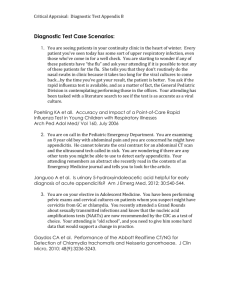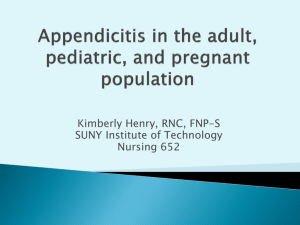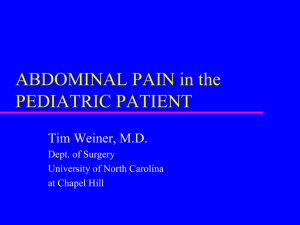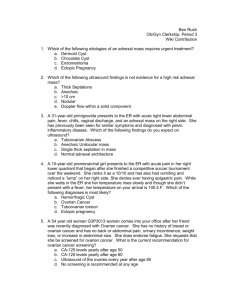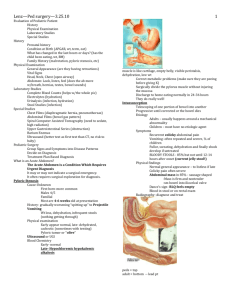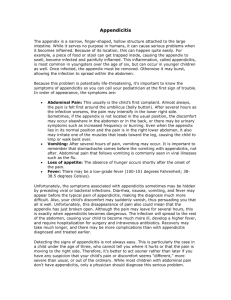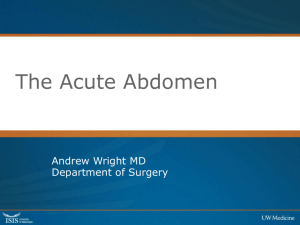24. Acute abdominal pain in a young woman: gynaecology or
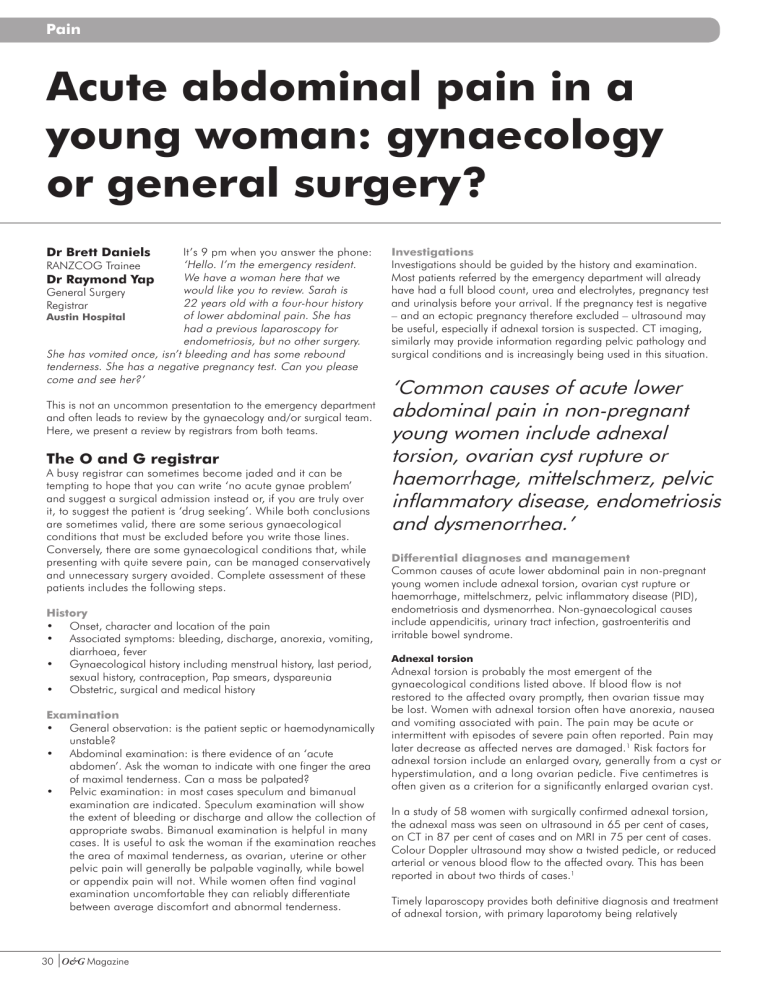
Pain
Acute abdominal pain in a young woman: gynaecology or general surgery?
Dr Brett Daniels
RANZCOG Trainee
Dr Raymond Yap
It’s 9 pm when you answer the phone:
‘Hello. I’m the emergency resident.
We have a woman here that we would like you to review. Sarah is
General Surgery
Registrar
Austin Hospital
22 years old with a four-hour history of lower abdominal pain. She has had a previous laparoscopy for endometriosis, but no other surgery.
She has vomited once, isn’t bleeding and has some rebound tenderness. She has a negative pregnancy test. Can you please come and see her?’
Investigations
Investigations should be guided by the history and examination.
Most patients referred by the emergency department will already have had a full blood count, urea and electrolytes, pregnancy test and urinalysis before your arrival. If the pregnancy test is negative
– and an ectopic pregnancy therefore excluded – ultrasound may be useful, especially if adnexal torsion is suspected. CT imaging, similarly may provide information regarding pelvic pathology and surgical conditions and is increasingly being used in this situation.
This is not an uncommon presentation to the emergency department and often leads to review by the gynaecology and/or surgical team.
Here, we present a review by registrars from both teams.
The O and G registrar
A busy registrar can sometimes become jaded and it can be tempting to hope that you can write ‘no acute gynae problem’ and suggest a surgical admission instead or, if you are truly over it, to suggest the patient is ‘drug seeking’. While both conclusions are sometimes valid, there are some serious gynaecological conditions that must be excluded before you write those lines.
Conversely, there are some gynaecological conditions that, while presenting with quite severe pain, can be managed conservatively and unnecessary surgery avoided. Complete assessment of these patients includes the following steps.
‘Common causes of acute lower abdominal pain in non-pregnant young women include adnexal torsion, ovarian cyst rupture or haemorrhage, mittelschmerz, pelvic inflammatory disease, endometriosis and dysmenorrhea.’
History
• Onset, character and location of the pain
• Associated symptoms: bleeding, discharge, anorexia, vomiting, diarrhoea, fever
• Gynaecological history including menstrual history, last period, sexual history, contraception, Pap smears, dyspareunia
• Obstetric, surgical and medical history
Examination
• General observation: is the patient septic or haemodynamically unstable?
• Abdominal examination: is there evidence of an ‘acute abdomen’. Ask the woman to indicate with one finger the area of maximal tenderness. Can a mass be palpated?
• Pelvic examination: in most cases speculum and bimanual examination are indicated. Speculum examination will show the extent of bleeding or discharge and allow the collection of appropriate swabs. Bimanual examination is helpful in many cases. It is useful to ask the woman if the examination reaches the area of maximal tenderness, as ovarian, uterine or other pelvic pain will generally be palpable vaginally, while bowel or appendix pain will not. While women often find vaginal examination uncomfortable they can reliably differentiate between average discomfort and abnormal tenderness.
Differential diagnoses and management
Common causes of acute lower abdominal pain in non-pregnant young women include adnexal torsion, ovarian cyst rupture or haemorrhage, mittelschmerz, pelvic inflammatory disease (PID), endometriosis and dysmenorrhea. Non-gynaecological causes include appendicitis, urinary tract infection, gastroenteritis and irritable bowel syndrome.
Adnexal torsion
Adnexal torsion is probably the most emergent of the gynaecological conditions listed above. If blood flow is not restored to the affected ovary promptly, then ovarian tissue may be lost. Women with adnexal torsion often have anorexia, nausea and vomiting associated with pain. The pain may be acute or intermittent with episodes of severe pain often reported. Pain may later decrease as affected nerves are damaged.
1 Risk factors for adnexal torsion include an enlarged ovary, generally from a cyst or hyperstimulation, and a long ovarian pedicle. Five centimetres is often given as a criterion for a significantly enlarged ovarian cyst.
In a study of 58 women with surgically confirmed adnexal torsion, the adnexal mass was seen on ultrasound in 65 per cent of cases, on CT in 87 per cent of cases and on MRI in 75 per cent of cases.
Colour Doppler ultrasound may show a twisted pedicle, or reduced arterial or venous blood flow to the affected ovary. This has been reported in about two thirds of cases.
1
Timely laparoscopy provides both definitive diagnosis and treatment of adnexal torsion, with primary laparotomy being relatively
30 O&G Magazine
Pain uncommon. Detorsion (untwisting of the pedicle), with or without cystectomy, drainage or oophoropexy is currently the mainstay of treatment for adnexal torsion, even if the ovary appears infarcted.
1 gynaecologist for assessment. Urinalysis should be performed on all women presenting with lower abdominal pain and any pathology treated or referred appropriately. Other surgical causes of abdominal pain will be discussed below.
‘Lower abdominal and pelvic pain can be diagnostically difficult and the borderline between gynaecological and general surgical issues is sometimes blurred.’
Ovarian cyst rupture and haemorrhage
Sometimes grouped with adnexal torsion as ‘cyst accidents’, ovarian cyst rupture and haemorrhage often present with a sudden onset of severe lower abdominal pain that slowly resolves.
Mittelschmerz is generally mild pain associated with normal follicle rupture at ovulation. More severe cyst rupture is often associated with rupture of a corpus luteum between days 20–26 of the menstrual cycle. Pain from cyst rupture is due to peritoneal irritation while pain from cyst haemorrhage is thought to be due to stretching of the ovarian capsule.
The gynaecological conclusion
The care of women is the essence of our chosen specialty. Lower abdominal and pelvic pain can be diagnostically difficult and the borderline between gynaecological and general surgical issues is sometimes blurred. We should not try to make a black-and-white distinction where none actually exists. Serious conditions need to be excluded and each woman treated sensitively and safely.
The surgical registrar
This extremely common scenario can be a source of tension between general surgery, O and G and the emergency department, with no one willing to accept the patient. However, a diagnosis of appendicitis always needs to be excluded. This may mean admission for a period of observation and a laparoscopy if the patient deteriorates or the pain does not resolve. Patients whose likelihood of appendicitis is low, pain control adequate and who live close to the hospital with others, may be observed at home, with re-presentation if symptoms worsen. Other surgical differentials are possible; however, they are not as important, as explained below.
Most women with a ruptured cyst are stable and require conservative management with adequate pain relief. Women with signs of excessive bleeding and hypovolaemia, or a history of coagulopathy, require closer monitoring and occasionally surgery to control bleeding. Ultrasound can be useful to exclude more serious pelvic pathology. In the case of a ruptured cyst, there may be some free fluid in the pelvis. A blood clot may be seen within a cyst in the case of a haemorrhagic cyst. A follow-up ultrasound six weeks later will confirm that the cyst has resolved.
PID
PID may present as pelvic pain, but is generally less acute in onset than cyst rupture or haemorrhage and less severe than in ovarian torsion. A history of vaginal discharge, fever, previous PID or a change in sexual partner or practice all make a diagnosis of PID more likely. Recent gynaecological procedures including D+C or insertion of an IUD are also relevant. On examination, there may be general lower abdominal pain in a haemodynamically stable patient. Speculum examination may reveal a vaginal discharge and allows the collection of vaginal and endocervical swabs.
An endocervical swab may be replaced by a first pass urine for chlamydia PCR, if desired. It is important that PID is treated and that follow-up is arranged. In particular, chlamydia is increasingly common in Australia and can have long-term consequences for fertility if left untreated. If you are uncertain that the woman will attend follow-up then a one-off dose of azithromycin (1 g orally) is useful in treating chlamydia.
Appendicitis
A consultant once said to me, ‘Never trust an appendix.’
This statement reflects the presentation of appendicitis is not straightforward and can often come in a variety of ways.
Nonetheless, there are features that make the condition more likely.
On history, the most important features are related to the nature of the pain: increasing right iliac fossa (RIF) pain that may have moved from the umbilical region. Supporting symptoms include fever, nausea and vomiting and anorexia. A couple of loose stools do not exclude appendicitis – an inflamed appendix may cause decreased transit time. Watery, frequent diarrhoea is almost always inconsistent with appendicitis – think gastroenteritis. It is important to ensure the patient still has an appendix – there have been a number of times where I have been asked by the emergency department for a supposed appendicitis only to see a large gridiron incision from a previous appendicectomy.
Careful examination can often add much to the picture. Close attention to the exact location and nature of the patient’s tenderness can be very helpful. Although the appendix does have a variety different locations, tenderness over McBurney’s point (one-third the distance between the anterior superior iliac spine and umbilicus) is surprisingly constant in appendicitis, although not definitive.
Remember, on overweight and obese patients the umbilicus droops down and, correspondingly, the true location of McBurney’s point may be higher than otherwise appreciated. Rebound tenderness is also useful – ask the question if the patient has more tenderness when you let go or press. Patients with appendicitis will complain that their pain is worse when you let go.
Endometriosis and dysmenorrhea
Some women presenting to hospital with acute pelvic and lower abdominal pain will have a history of endometriosis. Symptoms include dysmenorrhea, dyspareunia, dysuria and dyschezia. These women may have had previous medical and surgical treatment for endometriosis. While there may be severe pain associated with endometriosis, urgent surgical treatment is rarely required and analgesia is the primary management. Unless adnexal torsion or haemorrhage is suspected, imaging can be arranged electively.
Similarly, women with severe dysmenorrhea may present to hospital for analgesia. Careful history taking and examination will often allow more emergent conditions to be excluded.
Non gynaecological causes
Urinary tract infection and renal colic may be referred to the
The most important investigations are of the white blood cell count
(WBC) and C-reactive protein (CRP). Early stages of appendicitis may have a normal result for both; however, the number of times I can recall finding acute appendicitis when the WBC and CRP were normal are very few and far between. Almost certainly, if the patient has had pain for more than two days and the CRP is normal, the chances of appendicitis are almost nil, remembering that there is an up to 48-hour lag in the CRP rising in response to inflammation.
Ultrasound, unfortunately, only has a 60–80 per cent sensitivity and specificity for acute appendicitis and cannot be relied upon. The report often states that they could not find anything in the RIF. Useful
Vol 13 No 1 Autumn 2011 31
Pain aspects of ultrasound are to exclude ovarian pathology and that the lack of free fluid in the pelvis pushes the diagnosis away from appendicitis. Beware of the report that states a tubular structure can be seen – this is often reported as an acute appendicitis and, without correlating history and examination, can be misleading.
CT has higher rates of sensitivity and specificity (80–90 per cent); however, again, a negative CT does not rule out appendicitis and it is undesirable to irradiate young women on a frequent basis.
A useful score that is often quoted is the Alvarado score 2 , which summarises the above points (see Table 1).
Table 1: The Alvarado score.
Symptom/Sign
Abdominal pain that migrates to RIF
Anorexia or ketones in the urine
Nausea or vomiting
Tenderness in the RIF
Rebound tenderness
Fever (T >37.3)
Leukocytosis
Neutrophilia
Point value
1
1
1
2
1
1
2
1 found during laparoscopy. If it appears normal, it is unlikely to be the cause of the pain. It is debatable if it should be removed if normal, but many argue that as it is likely to cause morbidity later, it should be removed if found.
‘Appendicitis always needs to be carefully considered. Although the mortality from appendicitis is rare in the Western world...it is still a highly morbid condition, especially if the appendix perforates.’
The surgical conclusion
Appendicitis always needs to be carefully considered. Although the mortality from appendicitis is rare in the Western world, with good access to health care, it is still a highly morbid condition, especially if the appendix perforates. A period of observation can be useful +/- a diagnostic laparoscopy. Other surgical conditions need to be thought of; however, they can usually be easily excluded in this age group.
Interpretation of the score is as follows:
• 0–4 unlikely to be appendicitis
• 5–6 consistent with a diagnosis of appendicitis
• 7–8 probable appendicitis
• 9–10 very probable appendicitis
The Alvarado score has reasonable rates of sensitivity and specificity
– multiple studies have shown that a score of between 0–4 make appendicitis very unlikely. However, the literature also suggests it is less reliable in young women.
References
1 Bottomley, C., Bourne, T. ‘Diagnosis and management of ovarian cyst accidents.’ Best Practice & Research Clinical Obstetrics and
Gynaecology 23 (2009): 711-724.
2. Alvarado A. A practical score for the early diagnosis of acute appendicitis. Ann Emerg Med 1986; 15: 557-564
In those patients where the diagnosis is unclear, a period of observation may be useful. If the patient deteriorates or the pain does not resolve or lessen, a diagnostic laparoscopy may be appropriate.
Here coordination between the surgical and O and G teams can be helpful – it little matters who is doing the diagnostic laparoscopy as long as whatever problem is seen is dealt with appropriately.
Managing Obstetric
Emergencies and Trauma
(MOET) in 2011
Other surgical differentials
There are other differentials in the young woman with RIF pain.
However, these can be easily ruled out, are uncommon or the management is very similar to appendicitis:
• An incarcerated inguinal or femoral hernia is very uncommon in this age group, but – if truly strangulated – a surgical emergency. Although you might think that it is an obvious and straightforward diagnosis, it is surprising how many doctors do not look for this.
• A first attack of Crohn’s disease can often present with this picture. However, the lack of bloody or mucus-filled stool makes this very unlikely. Treatment usually is conservative until a diagnosis can be made on delayed colonoscopy.
• Mesenteric adenitis, although not common in this age group, is a differential. The lack of a raised WBC and a recent history of viral illness make this more likely. Treatment is conservative and patients need to be warned that the pain can last for a considerable time, although it should lessen.
• Meckel’s divecticulum, as you may recall, is a true congenital diverticulum, appearing on the antimesenteric border of the distal ileum with its own mesentery. The common mnemonic is the rule of twos: two per cent of the population, two inches long, two feet from distal ileum, two-thirds true. However, its presentation is very similar to appendicitis and is often only
MOET Courses:
Sydney: 8–10 April
Melbourne: 18–20 November
MOET Instructor Course:
Sydney: 7–9 October
Annual MOET Instructor update day:
Sydney: 11 October (TBC)
More information is available from: http://www.moetautralia.com.au
Proudly supported by RANZCOG.
PR/CRM points will be available.
32 O&G Magazine
